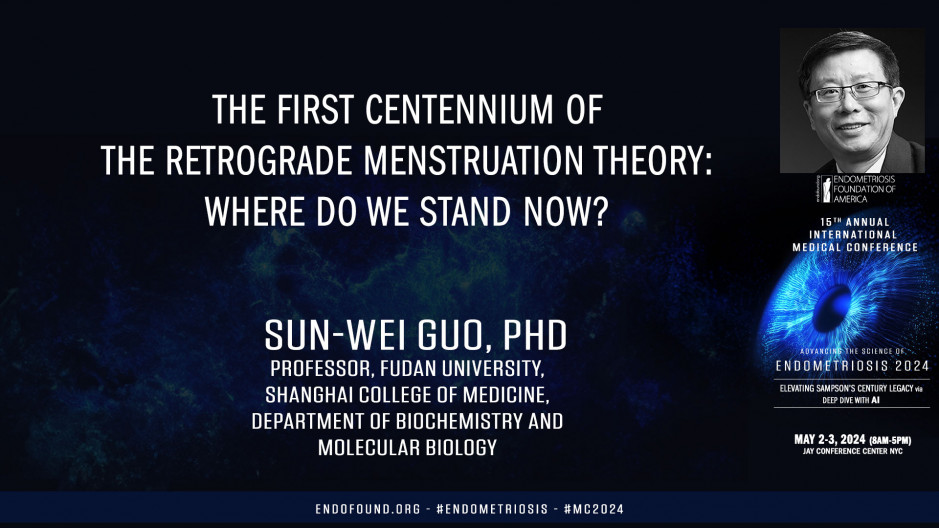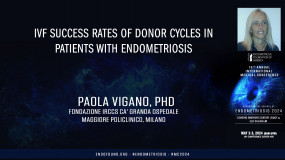International Medical Conference
Endometriosis 2024:
Elevating Sampson’s Century Legacy via
Deep Dive with AI
For the benefit of Endometriosis Foundation of America (EndoFound)
May 2-3, 2024 - JAY CENTER (Paris Room) - NYC
It is actually by far the most widely accepted to hypothesis for the genesis of miosis. And also the has the most supporting evidence, either from animal experimentations and also from epidemiological data. But there's a gap between the near ubiquity of retrograde menstruation and also there's only a fraction hormone actually developed mitosis. In fact, if you consider each specific prevalence, the gap will be even more striking. There are also other challenges to this theory. For example, extra pelvic endometriosis and also endometriosis in pre ocular growth. And also occasionally men receiving hormonal treatment due because of prostate cancer. And over the years, many theories of hypothesis have been proposed to explain why this is a gap. And stem cell theories actually also widely accepted and also has been revised recently. And I think that the challenge is to find a well-accepted biomarker for stem cells. And also there's a notion that the endometriosis due to the
Okay it on from the
Bottom. Oh, okay. Thank
You. Just put it there. Okay.
Ends due to the evolutionary mal adaptation, but presumably these mal adaptations seem to be sweeping and across the board. And so the question still is why there are only a fractional developed endometriosis, not all of them. And also there are some molecular genetic evidence because of the sharing of cancer associated mutations or cams in eutopic as well as in the ectopic endometrial. And this has been taken as evidence that the actually endometriosis section lesions are derived from intermission with the cams. But we do know that the normal intervention also harbors certain cams and tissues harboring these cams have a selective advantage in this manifesting as reproductive advantages, which could actually could take over most of the clones and without causing any overt pathology. And one thing that is striking is the frequency of cams actually increases with age suggesting this is actually due to the replication error.
And there are also certain hoops we have to jump through in order to prove there's a causal relationship. First of all, we need to approve that there's a temporal relationship. Essentially endometrial aberration occurs first and then endometriosis. But there are certain evidence suggesting some of the endometrial aberrations is actually due to the consequence of endometriosis. For example, some of the epigenetic changes with the ox ATM hypermethylation and also one of the proteins involved in epigenetic modification is the H stack. Three downregulation also happens once you induce in osis in mouse, you can actually see these changes and also in BA balloons. And very interestingly, Hutus group reported that all these in mutual aberrations lesions corresponds to the proximity lesions to the uterus, which is actually very, very interesting. And also we have to prove that there's a differential risk for women with cam carrying endometrial. They'll have increased risk of developing endometriosis for those without actually will have reduced or even no risk of developing endometriosis. But mostly importantly, we have to show there's a clear phylogenetic relationship between the lesions and also the atopic endometrial. And this is actually not very easy. I'm going to show that that sick liver, cause on one hand the, oops, sorry.
See? Okay. On the one hand, the lesions actually individually, they are actually monoclonal. On the other hand, the entire endometrium is actually polygram. Now each circle represents different clones. Now both are actually evolving. And once you identify this clone, you're going to say, okay, this is come from a particular clone. It's going to be very, very difficult. You don't know which clone. And also because these clones may have a selective advantage, they eventually is going to take over most of Crohn's, creating what I call is a survival bias. So it is actually not easy and we have to ask ourself what we have actually missed. Historically, lavender and Mario as actually they published in 1560s, suggesting there are certain substance or factors inherent in the menstrual degrees that will facilitate the development of or implantation of endometrial cells. Although these factors or substance have never been identified, we also seem to make certain assumptions which may or may not be held in reality.
For example, each cycle menstrual degrees contain all the ingredients required for successful implantation. And just one round of retrograde menstruation could implant a lesion and once a topically the implant would develop into a lesion. The later causes symptoms. 22 years ago, land deck and his associates actually proposed that actually it's just a retrograde menstruation is not enough. It has to contain basal endometrium. Obviously not all retrograde menstruation contains the basal endometrium. And we have to ask ourselves, what is special basal endometrium? Now, basal endometrium is actually part of the endometrial myometrial interface, also known as the junction zone and what is special about junction zone. And we know that it is the origin of uterine contractions and also is a rich in nerve fibers including strong cells. Now we actually demonstrated that if you breach the junction zone, you actually will develop alysis. And we have shown that the strong cells, which is actually top of neurons, they can actually be damaged during the breach.
And when strong cells are actually damaged, they're going to differentiate, they can to acquire a stem cell like phenotype. And also they actively participate in tissue repair, which actually very relevant. And we actually have that data to show that the D differentiating strong cells actually can facilitate epithelial medicine camel transition in endometrial epithelial cells. But these D differentiates strong cells themselves actually can be turned into endometrial epithelial like cells and can be further coaxed into endometrial stromal cells. Of course, there's some other evidence, for example, it's been reported that Nin J one is expressed in metic lesions, which actually is involved in neuro injuries. And of course whether it's actually secreted by your strong cells, it has to be investigated. And it's also very nice paper published by Jacque Group. And they actually induce endometrial nodules in baboons. But what is interesting, they used four types of tissues. One is end endometrium only. The other one is the mal mutual only. The third one is the endometrium plus the junction zone. And the fourth one is the fourth thickness including mal, the junction zone, and also the marum. And guess what?
When used all these four different tissue types, the fourth thickness, the one actually generated the lesions that are the largest and also has some more adhesions followed by inter plus the junction zone, suggesting that something within the junction zone or the other parts of the uterine tissues will facilitate or somehow enhance the implantation of lesions. And interestingly, this has been seem to be echoed by a mouse study. The mouse study essentially said they also use different the tissues compositions. And the bottom line is as the full thickness fragments injected into the peritoneum, the recipient mice actually are the most resistant to clearance. Other types of lesions, actually they easily can be easily cleared up. So that's actually another thing that somehow something within the junction zone or that the uterus actually will be facilitative to form the lesions. Now, if we also eyeball the anatomical allocation of ov endometrioma, deep endometrial lesions will see that we know that there's a phenotypical differences. For example, this one has more fibrotic content. Oops, sorry, go back.
And if I bought this picture long and hard, we'll understand that the de lesion of deep endometriosis, actually they're always in proximity to sal nerve plexus, which contains sensory nerves and also synthetic nerves. And we do show that. We have shown that if you silver, these nerve fibers, actually the lesions in terms of progression will be slowed down. And with this actually, we have shown that just by injecting extra neuropeptides, we can actually generate a mouse model of deep in miosis. So the message is on retrograde menstruation may not be sufficient to establish endometrial lesions. Rather, there's a need for additional factors, which could be endometrial mass and camel stem cells, nerve fibers or simply neuropeptides. And this actually could, Illumina, I think can be the gap. And of course there's some other considerations and the amount, a number of retrograde administrations because in many experimental animal models, and you can see that this actually ask is work.
And he used the two inoculations on two consecutive menstrual cycles. And this amount. And also the number of retrograde menstruation is usually more than the regular retrograde administrations. And also one, my friend that Dr. J actually modeled the prevalence data based upon number of inoculations. And the result is he actually used this population based prevalence data and found that if there are two inoculations, and that actually fits the data the best, suggesting that at least it needs two inoculations on leverage. And of course, there's also some other considerations. For example, compromised host immunity that actually the results of failure in removing al debris and the compromise host immunity could be attributed to chronic stress because has been demonstrated that chronic psychological stress could actually impair cellular as well, immuno immunity. And there also could be a merit, other factors resulting from evolutionary mismatches. It could be some many other things, dyes, lifestyles, environmental changes.
So in conclusion, after nearly a century, the retrograde menstruation theory can explain a lot of things, but it's a little bit difficult to explain the gap. And it's likely there are more than one cause of endometriosis. And the gap could be explained by the notion that not all retrograde menstruation are the same, and it's a successful e lesion through retrograde menstruation may require, for example, multiple episodes and specific composition of men tissues, for example, stem cells and no fibers, and also simply or neuropeptides and identification of them. I think that will help us to get to the bottom of the pathogen is. So with this, I'll end my talk by thanking Dan to the LADA substance, Mario Factors, and also Dr. Jean for sharing this data. Thank you.










